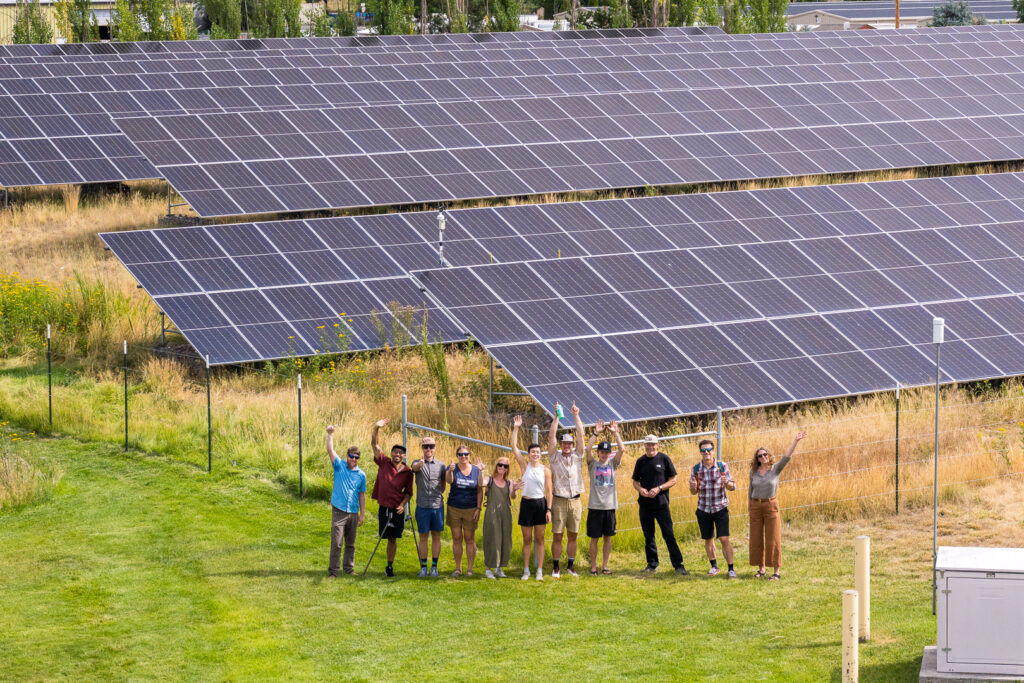Cheaper, Faster, Stronger: The Business Case for Clean Energy
Photo by Donny O’Neill
Clean energy is cheaper, faster, and more reliable than fossil fuels, but local misinformation is slowing progress. We caught up with POW’s Director of Campaigns, Lindsey Halvorson, to explore how businesses can take action and drive clean energy solutions in their communities.
POW: OK, what is the clean energy campaign, and what is POW trying to achieve?
Lindsey Havorson: To start, we will advance 500 MW of clean energy by 2026 and 1 GW by 2028!
Here is what we know to be true: clean energy like wind and solar is just cheaper, faster to build, and more reliable than traditional sources of energy like fossil fuels. Even without the CO2 emissions argument, clean energy is just a better source of energy for our communities. And we need it! Solutions like rooftop solar and behind-the-meter systems are important, but they will not be enough to power our communities and meet our greenhouse gas emissions reduction goals. We need clean energy at scale, and we need it quickly.
We also know that more than two-thirds of voters (69%) say they’d be proud of renewable energy development in their community. However, in many communities, a vocal minority is spreading misinformation and hindering projects that could benefit their community.
That’s where POW and the Outdoor State come in. It’s time we gear up and get in the fight. If we can organize a few key voices at the local level, we can change the decision from a ‘no’ to a ‘yes’.

POW: What examples have you seen of businesses successfully integrating local clean energy into their operations, and what benefits have they realized?
LH: Let’s use AspenOne as our example here. After seeing energy efficiency projects only be able to shave marginal GHG emissions reductions, they reevaluated their approach to take a more systemic solution strategy. Their utility provider is Holy Cross Energy, a Rural Electric Cooperative (REC) with elected board members, making it subject to political pressure. They advocated for their utility and local governments to prioritize and build local clean energy. And it worked. Holy Cross achieved a 96% renewable energy portfolio in spring 2025. That’s clean energy for AspenOne and the rest of the utility area.
POW: Sounds like POW is advocating for clean energy beyond rooftop solar and renewable energy credits to meet sustainability goals?
LH: Yes. Roof top and REC’s sometimes have a place and time, but we think about our communities in a whole picture. We all live on the same planet, draw our energy from the same grid, and aim to build a future that is both resilient and supportive of our community.
When we advocate for larger local projects and utility-scale initiatives, we are helping a community as a whole reach its sustainability goals while providing resilient power and potentially increasing local tax revenue for schools and counties. Chipping away at the in-house greenhouse gas (GHG) goal is really tough work! Our proposition is to reframe the work to advocate at both local and policy levels, making it easier, while transitioning your whole community to clean energy.
POW: You have talked about resiliency quite a bit. Let’s dig in and learn more about how clean energy can help the industry become more resilient.
LH: Here is my question to businesses: Have you seen your energy costs increase over the last few years? Anyone using fossil fuels directly? Natural gas? Diesel? Propane? I sure have!
These are volatile markets subject to political pressure and many supply chain hurdles. Clean energy (solar, wind, geothermal) is less directly subject to these market pressures. We can generate the energy domestically. Additionally, we will continue to see the levelized cost of clean energy (solar and wind) come in at a lower price per megawatt hour than fossil fuels, even without government subsidies. That’s good for the balance sheet and building a power source that is not dependent on shipping ancient fossils around the world. The sun and wind are FREE!
An example of this is a 5 MW project we supported in 2019 in Pitkin County, CO, which came online in 2023. When a wildfire came ripping through the valley, it was that project that helped provide the redundancy needed to power communities if the transmission line went down. That’s real resilience in the face of a changing climate.
POW: What role can businesses play in building partnerships with local governments, utilities, or nonprofits to scale clean energy solutions?
LH: You know who some of the most influential and powerful voices are to local decision makers? Local businesses. Talking to a decision maker, like a county commissioner or other elected official, can make or break a campaign. I promise that is not an exaggeration. Even using your business’s voice in a local op-ed or letter to the editor can help persuade others in your community to be brave.
That is where the outdoor community has a unique advantage. The sports we do are hard, and sometimes getting to the top of that mountain is not straightforward. Inherently, we are solutions-oriented. All clean energy campaigns are a conversation and an opportunity to find solutions to huge problems.
Who better to do that than us?
